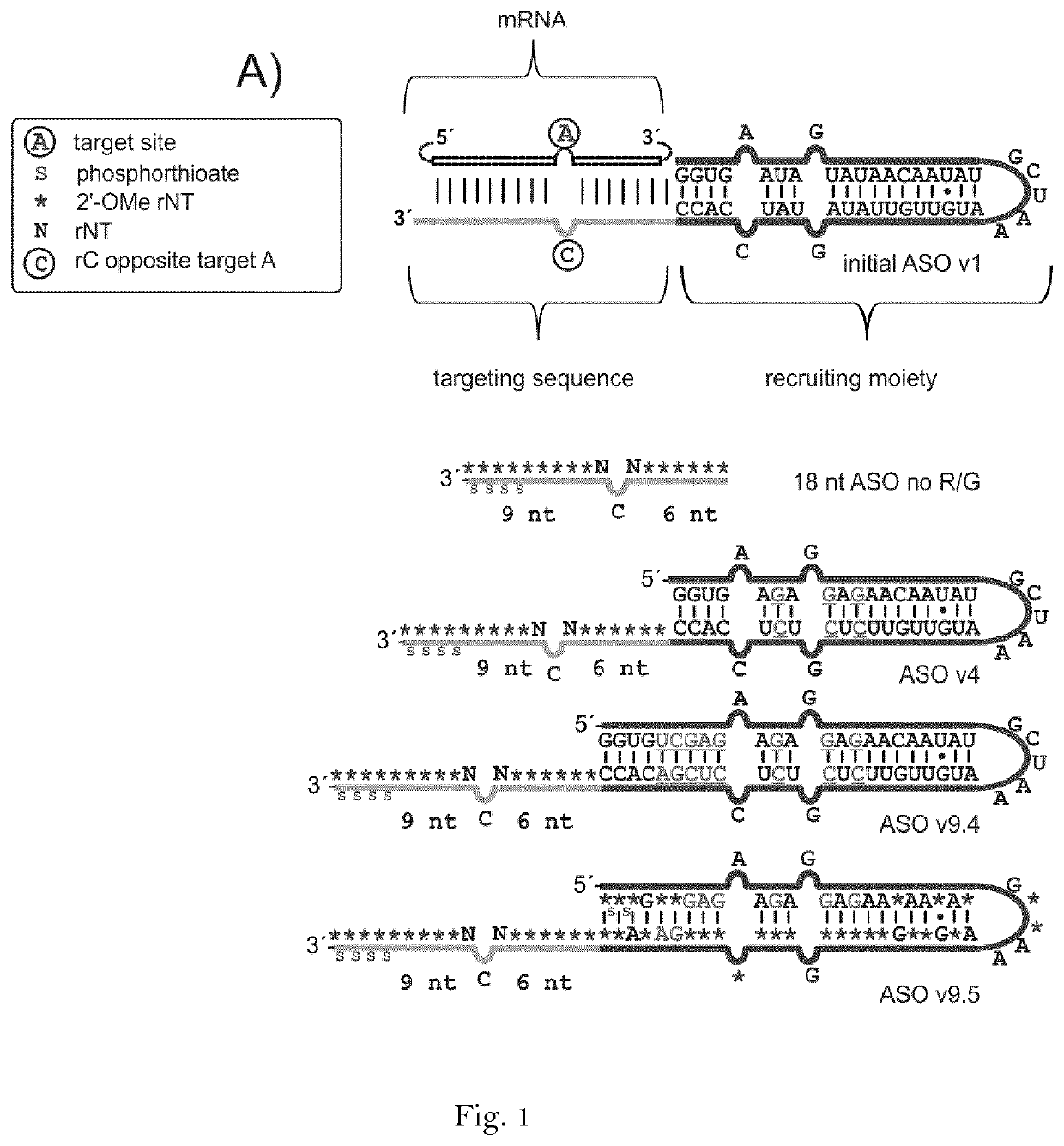Artificial nucleic acids for RNA editing
a technology rna, applied in the field of artificial nucleic acids for rna editing, can solve the problems of many manipulations of gene expression that are not feasible or ineffective at the genome level, and the strategy known in the art suffers similarity, and it is difficult to recruit deaminase, in particular endogenous deaminase, to achieve the effect of rna, and reducing the number of rna
- Summary
- Abstract
- Description
- Claims
- Application Information
AI Technical Summary
Benefits of technology
Problems solved by technology
Method used
Image
Examples
example 1
[0169]Unmodified RNA oligonucleotides were produced by in vitro transcription from linear synthetic DNA templates (purchased from Sigma-Aldrich, Germany) with T7 RNA polymerase (Thermo Scientific, USA) at 37° C. overnight. The resulting RNA was precipitated in ethanol and purified via urea (7M) polyacrylamide (15%) gel electrophoresis (PAGE), extracted into water, precipitated with ethanol and resuspended and stored in nuclease-free water. All chemically modified RNA oligonucleotides purchased from Biospring (Germany), Eurogentec (Belgium) or Dharmacon (USA). Long sequences were assembled from two pieces by ligation. As a first step, a plasmid-borne approach was applied in order to screen for suitable guideRNA sequences. A reporter editing assay (FIG. 1B), led to the identification of sequence variant 9.4 that has additional 5 bp at the 5′-site of the RNA helix in the ADAR recruiting domain.
[0170]In the reporter editing assay, Firefly luciferase was expressed under control of a CMV ...
example 2
[0176]In a further series of experiments, endogenously expressed ADAR was harnessed for the editing of a 5′-UAG codon in the 3′-UTR of the two housekeeping genes GAPDH and ACTB in HeLa cells by simple lipofection of the respective ASOs.
[0177]To this end, HeLa cells (Cat. No.: ATCC CCL-2) were cultured in DMEM+10% FBS+P / S (100U / mL penicillin and 100 μg / mL streptomycin. 5×104 cells in 100 μL DMEM+10% FBS 600 units IFN-α, Merck, catalog number IF007, lot number 2937858) were added to a transfection mix of 0.5 μL Lipofectamine 2000 and 5 pmol guideRNA / well in a 96-well format. For concurrent editing with two different ASOs, 2.5 pmol of each respective ASO were co-transfected. After 24 hours cells were harvested for RNA isolation and sequencing.
[0178]A control ASO comprising only of the specificity domain but lacking the ADAR recruiting domain did not elicit any editing (FIG. 1A, 2A). Some editing was observed with the initial sequence v1 and the design v4 (FIG. 2A). However, the new seq...
example 3
[0189]Following the characterization of ASO design 9.4 for the editing of 5′-UAG triplets in the 3′-UTR, the editing of a 5′-UAG triplet in the ORF of GAPDH in ADAR-expressing 293 cell lines was tested with an ASO based on v9.4 (see also Example 1). Comparison of the editing yields obtained with the three ADARs showed that the editing yields in the ORF followed the same trend as in the 3′-UTR before (ADAR1p150>ADAR1p110 ADAR2), albeit with generally lower editing yields (11%-55%, see FIG. 3A).
[0190]The ASO architecture was further optimized in order to improve the on-target binding kinetics by increasing the length of specificity domain and by including LNA modifications. We identified ASO design v25, which comprises of the unaltered ADAR-recruiting domain, but contained a 40 nt specificity domain, which was partly modified by 2′-O-methylation, phosphorothioate linkage and contained three LNA modifications (FIG. 3B). After transfection into HeLa cells, ASO v25 achieved editing yield...
PUM
| Property | Measurement | Unit |
|---|---|---|
| Fraction | aaaaa | aaaaa |
| Fraction | aaaaa | aaaaa |
| Fraction | aaaaa | aaaaa |
Abstract
Description
Claims
Application Information
 Login to View More
Login to View More - R&D
- Intellectual Property
- Life Sciences
- Materials
- Tech Scout
- Unparalleled Data Quality
- Higher Quality Content
- 60% Fewer Hallucinations
Browse by: Latest US Patents, China's latest patents, Technical Efficacy Thesaurus, Application Domain, Technology Topic, Popular Technical Reports.
© 2025 PatSnap. All rights reserved.Legal|Privacy policy|Modern Slavery Act Transparency Statement|Sitemap|About US| Contact US: help@patsnap.com



